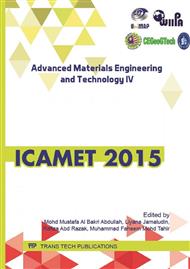[1]
Upadhyaya, A. and C. Ghosh, Effect of coating and activators on sintering of W-Cu alloys. Powder Metallurgy Progress(Slovak Republic), 2002. 2(2): pp.98-110.
Google Scholar
[2]
Kirk, T., S. Caldwell, and J. Oakes, Mo-Cu composites for electronic packaging applications. Advances in powder metallurgy and particulate materials, 1992. 9: pp.115-115.
Google Scholar
[3]
Sepulveda, J.L. and D.E. Jech, Copper-Tungsten Metal Matrix Composites for Packaging Heat Sink Applications. Tungsten Refractory Metals and Alloys, 1998. 4: pp.17-19.
Google Scholar
[4]
Boonyongmaneerat, Y., Effects of low-content activators on low-temperature sintering of tungsten. Journal of Materials Processing Technology, 2009. 209(8): pp.4084-4087.
DOI: 10.1016/j.jmatprotec.2008.09.026
Google Scholar
[5]
Chen, P., et al., Effects of Zn additions on the solid-state sintering of W–Cu composites. Materials & Design, 2012. 36: pp.108-112.
DOI: 10.1016/j.matdes.2011.10.006
Google Scholar
[6]
Hamidi, A.G., H. Arabi, and S. Rastegari, Tungsten–copper composite production by activated sintering and infiltration. International Journal of Refractory Metals and Hard Materials, 2011. 29(4): pp.538-541.
DOI: 10.1016/j.ijrmhm.2011.03.009
Google Scholar
[7]
Mohammad, K.S., A. Rahmat, and A.B. Ismail, The effects of Fe additions on the liquid phase sintering of W–bronze composites. Journal of Alloys and Compounds, 2009. 482(1): pp.447-454.
DOI: 10.1016/j.jallcom.2009.04.061
Google Scholar
[8]
Zhou, Y., et al., High performance tungsten synthesized by microwave sintering method. International Journal of Refractory Metals and Hard Materials, 2012. 34: pp.13-17.
DOI: 10.1016/j.ijrmhm.2012.02.016
Google Scholar
[9]
Mahani Yusoff, R.O., Zuhailawati Hussain, Mechanical alloying and sintering of nanostructured tungsten carbide-reinforced copper composite and its characterization. Materials & Design, 2011. 32: pp.3293-3298.
DOI: 10.1016/j.matdes.2011.02.025
Google Scholar
[10]
Luo, L. -M., et al., Sintering behavior of W–30Cu composite powder prepared by electroless plating. International Journal of Refractory Metals and Hard Materials, 2014. 42(0): pp.51-56.
DOI: 10.1016/j.ijrmhm.2013.10.012
Google Scholar
[11]
Abbaszadeh, H., et al., Investigation on the characteristics of micro-and nano-structured W-15wt. % Cu composites prepared by powder metallurgy route International Journal of Refractory Metals and Hard Materials, 2012. 30(1): pp.145-151.
DOI: 10.1016/j.ijrmhm.2011.07.017
Google Scholar
[12]
Ardestani, M., et al., Synthesis and densification of W–30  wt%Cu composite powders using ammonium meta tungstate and copper nitrate as precursors. International Journal of Refractory Metals and Hard Materials, 2009. 27(4): pp.796-800.
DOI: 10.1016/j.ijrmhm.2009.01.001
Google Scholar
[13]
Amirjan, M., K. Zangeneh-Madar, and N. Parvin, Evaluation of microstructure and contiguity of W/Cu composites prepared by coated tungsten powders. International Journal of Refractory Metals and Hard Materials, 2009. 27(4): pp.729-733.
DOI: 10.1016/j.ijrmhm.2008.12.008
Google Scholar
[14]
Yu, K., et al., Fabrication of W@ Cu composite powders by direct electroless plating using a dripping method. Journal of Wuhan University of Technology-Mater. Sci. Ed., 2013. 28(4): pp.829-833.
DOI: 10.1007/s11595-013-0777-3
Google Scholar
[15]
Mohammed, K.S. and A. Rahmat, The role of the activator rich-W interboundary layer on liquid phase sintering of W–pre-alloy bronze composites of Fe and Co additions. International Journal of Refractory Metals and Hard Materials, 2012. 35(0): pp.170-177.
DOI: 10.1016/j.ijrmhm.2012.04.016
Google Scholar
[16]
German, R. and Z. Munir, Enhanced low-temperature sintering of tungsten. Metallurgical Transactions A, 1976. 7(12): pp.1873-1877.
DOI: 10.1007/bf02659818
Google Scholar
[17]
Tiwari, S., P. Rajput, and S. Srivastava, Densification Behaviour in the Fabrication of Al-Fe Metal Matrix Composite Using Powder Metallurgy Route. ISRN Metallurgy, 2012. 2012: p.8.
DOI: 10.5402/2012/195654
Google Scholar
[18]
Igharo, M. and J. Wood, Compaction and Sintering Phenomena in Titanium—Nickel Shape Memory Alloys. Powder metallurgy, 1985. 28(3): pp.131-139.
DOI: 10.1179/pom.1985.28.3.131
Google Scholar
[19]
Upadhyaya, A., et al., Densification of Pre-Mixed and Pre-alloyed Cu-12Sn Bronze During Microwave and Convential Sintering. Advances in Powder Metallurgy and Particulate Materials, 2002(13): pp.13-362.
Google Scholar
[20]
Guo, R., P. Rohatgi, and D. Nath, Preparation of aluminium-fly ash particulate composite by powder metallurgy technique. Journal of materials science, 1997. 32(15): pp.3971-3974.
Google Scholar
[21]
Yamaguchi, K., N. Takakura, and S. Imatani, Compaction and sintering characteristics of composite metal powders. Journal of Materials Processing Technology, 1997. 63(1–3): pp.364-369.
DOI: 10.1016/s0924-0136(96)02648-9
Google Scholar
[22]
German, R.M., P. Suri, and S.J. Park, Review: liquid phase sintering. Journal of materials science, 2009. 44(1): pp.1-39.
Google Scholar
[23]
the library of manufacturing. Pressing and Sintering of Powder Parts. 2015 [cited 2015 02/05/2015]; Available from: www. thelibraryofmanufacturing. com/pressing_sintering.
Google Scholar
[24]
Li, C. and R. German, The properties of tungsten processed by chemically activated sintering. Metallurgical Transactions A, 1983. 14(10): p.2031-(2041).
DOI: 10.1007/bf02662370
Google Scholar


